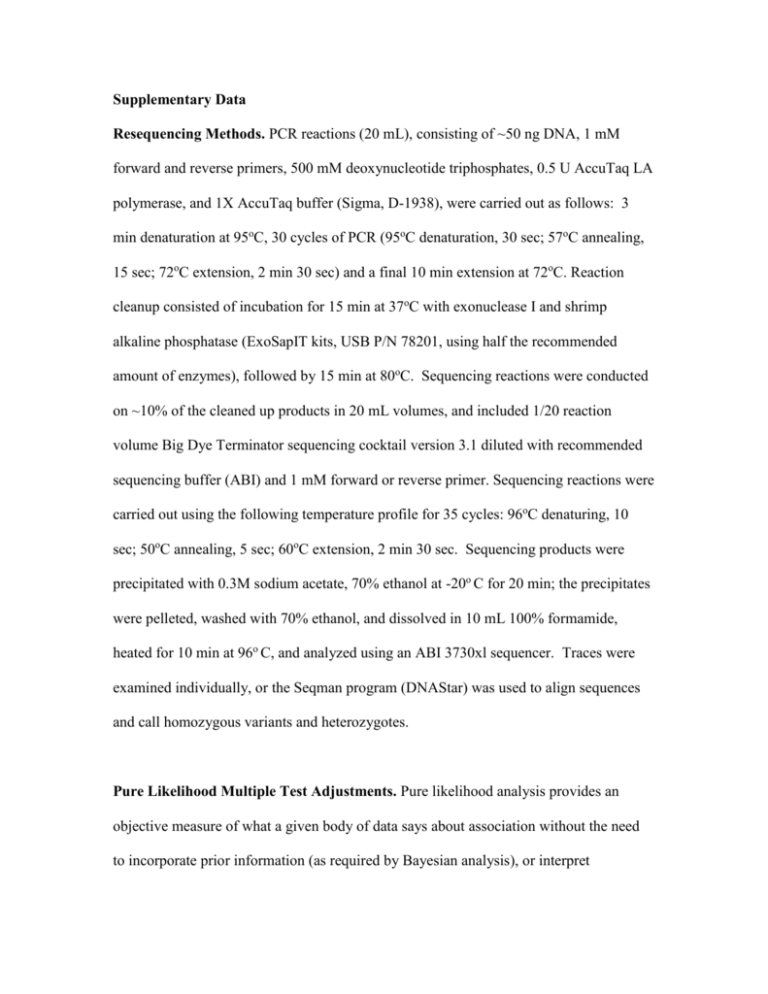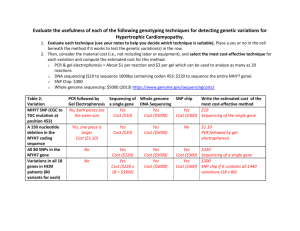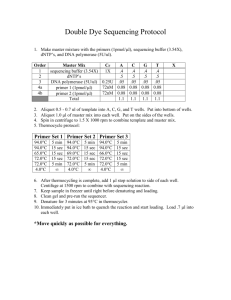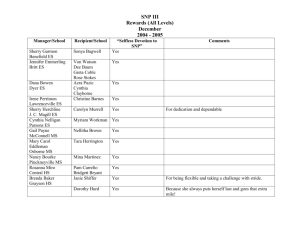Supplementary Data
advertisement

Supplementary Data Resequencing Methods. PCR reactions (20 mL), consisting of ~50 ng DNA, 1 mM forward and reverse primers, 500 mM deoxynucleotide triphosphates, 0.5 U AccuTaq LA polymerase, and 1X AccuTaq buffer (Sigma, D-1938), were carried out as follows: 3 min denaturation at 95oC, 30 cycles of PCR (95oC denaturation, 30 sec; 57oC annealing, 15 sec; 72oC extension, 2 min 30 sec) and a final 10 min extension at 72oC. Reaction cleanup consisted of incubation for 15 min at 37oC with exonuclease I and shrimp alkaline phosphatase (ExoSapIT kits, USB P/N 78201, using half the recommended amount of enzymes), followed by 15 min at 80oC. Sequencing reactions were conducted on ~10% of the cleaned up products in 20 mL volumes, and included 1/20 reaction volume Big Dye Terminator sequencing cocktail version 3.1 diluted with recommended sequencing buffer (ABI) and 1 mM forward or reverse primer. Sequencing reactions were carried out using the following temperature profile for 35 cycles: 96oC denaturing, 10 sec; 50oC annealing, 5 sec; 60oC extension, 2 min 30 sec. Sequencing products were precipitated with 0.3M sodium acetate, 70% ethanol at -20o C for 20 min; the precipitates were pelleted, washed with 70% ethanol, and dissolved in 10 mL 100% formamide, heated for 10 min at 96o C, and analyzed using an ABI 3730xl sequencer. Traces were examined individually, or the Seqman program (DNAStar) was used to align sequences and call homozygous variants and heterozygotes. Pure Likelihood Multiple Test Adjustments. Pure likelihood analysis provides an objective measure of what a given body of data says about association without the need to incorporate prior information (as required by Bayesian analysis), or interpret association evidence within the context of what would have been seen over multiple replications of the same experiment (Frequentist analysis). The pure likelihood approach also provides a way to control the probability of observing weak signals in the data, and provides an intuitive approach to multiple test adjustments. In the pure likelihood paradigm, one does not use error rates such as Type I and II error probabilities for design; instead the probabilities of misleading and weak evidence are controlled at the design phase of the study. For more on the pure likelihood paradigm see 18-21. Briefly, misleading evidence under the null hypothesis Mo is the analogous error rate to a Type I error rate, and measures the rate at which the LR will provide strong evidence favoring the incorrect hypothesis of association, as we want to ensure that the probability of observing lod-evidence of 1.5 favoring association at a SNP of interest, when that SNP is not associated, is very small. Mo is generally much smaller than a Type I error 21,46 and over multiple SNP tests, (N=44 for the discovery data set), the family-wise error rate (FWER) is bounded in this particular study by N* Mo= 0.088. By using our two-stage design this error probability is bounded by 0.044, and consequently the replication phase provides our adjustment for conducting multiple SNP tests. This is because the replication phase ensures that the FWER is controlled at acceptable levels, the whole point of multiple test adjustments. In a Frequentist analysis, if the significance criterion is set at 5%, then the FWER rate is controlled at 0.05. The probability of weak evidence (W) - the probability of obtaining a weak association signal, perhaps between 0.5 and 1.5, when in fact there is association - has no frequentist analog, and should be controlled during the planning phase of a study by choosing sufficient sample size to ensure this error rate remains low. For this study W was quite high, W=0.11 for a given SNP test, and due to the small sample size. However, fortunately, we observed some strong evidence in hELP4, and the a priori weak evidence probability associated with the study does not detract from the strong conclusions we can make about the hELP4 CTS association.







